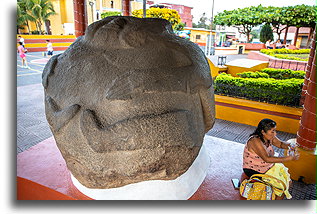Large stone sculptures are displayed around the square in small town of La Democracia, Guatemala. The sculptures were discovered in the nearby Monte Alto farmlands. They are characteristic of the Pacific lowlands. When were they created? Archaeologists are not sure. Some suggest that they may be from the late Preclassic period (500 BC to AD 100), when Monte Alto culture flourished and was the regional center.



Two types of statues can be distinguished among the sculptures from Monte Alto. The first is a group of human heads that closely resemble the Olmec colossal heads. The other sculptures are human bodies with a decidedly corpulent in appearance, they are often called potbellies.



The sculptures from Monte Alto resemble those of the Olmec civilization, which predates and coincides with Monte Alto. Similarities to the colossal Olmec heads suggest that the two cultures are somehow related. Did the Olmecs migrate to the Pacific lowlands or simply influenced the arts in the region? Archeologists do not have answer to this question yet.


In the sculptures of Monte Alto there is another interesting aspect. Most of them were found to have magnetic properties. Three basaltic heads have magnetic anomalies around their right temples and cheek areas. Researchers also found that the navel area of four potbellied sculptures displayed the most magnetism. It would be unusual to have such a pattern simply by chance. Were the artisans really aware of these properties? If so, they must have specially selected large rocks that were hit by lightning, magnetizing the material at some point in the past. But how artists detected magnetism 2000 years ago or more? Metal was not generally known in Mesoamerica until the arrival of Europeans in 1521. The sculptors from Monte Alto most likely used naturally occurring magnetic minerals in their works.







